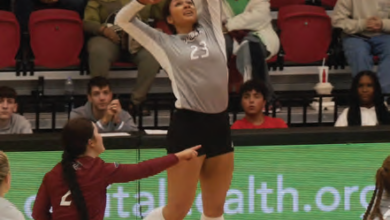
The loss of sports and its path back
By Dylan Manfre
Hello again. It’s been a while.
One hundred and eighty-two days ago was the last time I wrote a story that was printed in The Rider News sports section. Man, does that feel like an eon ago.
Let’s do some catching up, shall we?
The United States has endured the anguish and continued agony of the noval coronavirus pandemic.
We are still feeling the lasting effects of everything that has transpired since March.
I can only speak for myself but I certainly did not expect anything in the above paragraph to still be prevalent when The Rider News covered the Metro Atlantic Athletic Conference (MAAC) Basketball tournament in Atlantic City, New Jersey, in March, yet here we are.
How did we get here?
I was cautiously optimistic when Rider University released its “Resolved and Ready” plan for the upcoming semester on June 24. I pondered how we would cover sports under the assumption they would still be held.
Rider Athletic Director Don Harnum told The Rider News back in July there was no plan in place for stopping fans if they wanted to come to a game but said, “I have to think there’s going to be some kind of distancing or crowd limitations but I would hope that students outside could come to a soccer game or field hockey game.”
So, how did we get from wondering how many fans would be in the stands at a Rider soccer game to now debating whether the college basketball season will start on time? Or throwing around the possibility of a bubble format for college basketball as the NBA and NHL have eloquently executed.
Things began to materialize on July 17 when the MAAC set the first day of fall sports competition for Sept. 11 for soccer and volleyball (Sept. 18 for field hockey per the Northeast Conference). Maybe there would be fans at Ben Cohen Field after all.
Spoiler alert — the MAAC canceled fall sports 10 days later on July 27. So, no fans, unfortunately, however, it probably was the right move.
“A lot of it is the timing of when we had to bring athletes back, if we were going to play a normal schedule that usually is Aug. 3, and things were spiking nationally at that time,” Harnum told The Rider News. “The news was not good in terms of how different regions were handling the virus even though things were slowly looking better in New Jersey — even though we’ve had some hiccups along the way.”
Harnum added the factor of rapid COVID-19 testing still not being readily available where a result can be produced in an adequate time frame to know if an athlete is infected.
“We were trying to work with the NCAA by setting reasonable expectations for the start of fall sports, and within the MAAC we felt we shouldn’t rush athletes back earlier than the student body because of all the questions surrounding testing and the pandemic and infection rate levels,” MAAC Commissioner Rich Ensor told The Rider News. “So there were so many open-ended questions initially, we said no summer conditioning, and then we said nobody comes back until the student body comes back and we thought with that and Sept. 11 as a start date, if everything was moving along as most hopped, that we would have been able to have competition. As it turned out the infection rates went through the roof … So it all went into the mix and then we started having some other conferences around the region drop fall sports It just escalated. It was one … problem after another.”
Ensor believed the federal government’s handling of the COVID-19 pandemic was problematic simply because there was no concrete directive.
“We have not had national leadership saying Americans do x, y and z,’ so it’s been dropped to the governors to do all that and as a result, we got mixed messages all over the country and so students are no different than any other part of the population,” Ensor said.
To Harnum’s credit, operating college in the COVID-climate was difficult because of the mixed messages sent by the state of New Jersey in regards to quarantining, or even if New Jersey would allow in-person college at all.
“If you’re going to start in any normal fall schedule, you had to bring athletes back 14 days earlier just to quarantine before you could start and that kept changing every day,” Harnum said. “The Presidents of our conference who made the decisions just wanted a better, more secure environment to say ‘Yeah we’re going to play.’”
Where we can go
The decision to cancel the fall season and formulate a plan for students to safely return to campus was by no means easy and people in athletics and beyond deserve credit for the measures being taken.
Teams are now holding voluntary 30-minute workouts until Sept. 14 when official practices can begin.
According to multiple reports, the NCAA will decide in mid-September whether or not a delay to the college basketball season is necessary. The start date would likely eliminate games for the remainder of 2020 — who needs any more dread in this year anyway — and have the season begin around Jan. 1.
This is just one of the things the association is looking into.
Ensor even went as far as to say the chances of seeing sports played in the 2020 calendar year are “greater than 50%.” adding “I feel confident we’re going to have sports, I’m just not sure what the format is going to be.”
50% seems pretty high given what has transpired from last spring and this fall.
Buckle up people. It is not going to get any easier but the clock to decide the fate of winter sports has officially begun.



